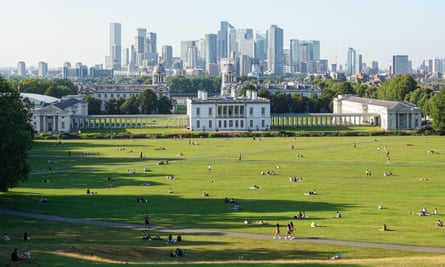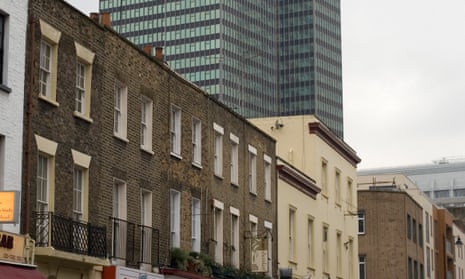Homes in the poorest areas of England have less than a third of the private garden space enjoyed by those in the richest, giving those residents a mental and physical health disadvantage that leads to worse outcomes from the cradle to the grave.
According to a Guardian analysis, in the richest 10% of areas in England, properties had 379m sq on average, compared with 114m sq in the poorest 10%. The analysis, based on data from the Office for National Statistics, also found that areas with the highest proportion of addresses without any garden space at all were often in more deprived areas.
In Somers Town, north London, among the 20% mostdeprived areas in the country, according to ONS figures, eight in 10 properties had no private outdoor space. In Ladywood-Summerhill, Birmingham, which is also among the poorest 20% of areas nationally, more than half of addresses had no garden.
Those with the very lowest levels of private outdoor space were in city-centre locations. The neighbourhood with the least access to garden space in England was in central Birmingham, where just 2% of addresses had outdoor space.
People from the poorest areas die on average 19 years younger than those from the wealthiest. While there are multiple factors of deprivation that contribute to that morbid inequality, campaigners warned that lack of access to nature affects people’s health and opportunities from childhood onward. Recent research has found that “living in areas with higher amounts of green spaces reduces mortality”, particularly from cardiovascular disease. And a study published in Environment International this week found that children living in areas with higher air pollution and very low levels of green space might have up to 62% increased risk of developing ADHD.
Richard Benwell, the chief executive of Wildlife and Countryside Link, said: “In combination with other inequality, lack of access to nature can exacerbate mental and physical health problems which harm quality of life and life expectancy. By contrast, even a short time in nature can lift our spirits and improve our health. So it’s the places without private gardens that need public investment in nature the most.
“This important analysis from the Guardian could provide a blueprint for government, targeting action and investment to green the greyest areas on the map for the benefit of people and wildlife. We’re encouraging the public to petition for a new legal ‘right to nature’ to help galvanise action from the treasury to local authorities to ensure that no one is left without nature near home.”

There are significant mental health benefits from access to green space. People who are more connected with nature are usually happier in life and more likely to report feeling their lives are worthwhile. And experiencing biodiversity, through bird species richness, plant species richness, habitat diversity and butterfly richness, is related to improved wellbeing, increased positive mood and lower levels of anxiety.
A 2014 review of evidence found that people “who are more connected to nature tended to experience more positive affect, vitality, and life satisfaction compared with those less connected to nature”. Natural England has estimated that if everyone in England had good access to green space it could reduce NHS pressures enough to save £2.1bn in health spending every year.
Across England, 12% of properties in the poorest areas had no garden space, compared with 8% in the richest. However, the lowest levels of garden access were found in the third-poorest group, where almost 15% lacked private outdoor space.
Previous research by the ONS has found that people from ethnic minority groups living in England were less likely to have access to a private garden. Nearly four in 10 black people had no access to private or shared garden, a patio or a balcony, making them the worst affected ethnic group. Separate research by Friends of the Earth found that people from minority ethnic groups were more than twice as likely as white people to live in areas in England that were most deprived of green space.
In 2019, the Institute for Public Policy Research (IPPR) established an environmental justice commission to address how the climate and nature crises intersected with economic and social injustice. Lesley Rankin, an IPPR researcher, said: “The pandemic has reminded us how important nature is for our health and wellbeing, but this research shows just how unequal access to quality green spaces is.
“IPPR has spoken to people around the UK as part of our citizens juries on climate and fairness and they couldn’t have been clearer about how important nature is to them, that everyone should be able to access it, and that government should make nature a priority. Alongside public green spaces, they also found gardens a crucial place to engage with nature.
“To address these stark inequalities, IPPR has called on the government to change planning rules so that all neighbourhoods benefit from nature, to put nature on the same footing as climate in national policy, and to invest £1bn a year in a National Nature Service.”
The analysis used data on private green space and deprivation at middle-layer super output area (MSOA) level. The average MSOA contains about 8,000 people.
All of the 10 local authorities with the lowest levels of garden space were in London, apart from Watford, which was in tenth place. Across the capital, just over a fifth of households had no garden space, the lowest proportion of any region. The highest levels of private outdoor space were found in the north-east, where 93% of properties had a garden.
However, previous ONS analysis has found that “parks are most accessible in the poorest areas, with people in the most deprived neighbourhoods of England around twice as likely as those in the least deprived to be within five minutes’ walk of a public park.”
While Somers Town residents have little garden space available, they have an average of 15 public green spaces within a kilometre radius, much higher than the national average.
Methodology
The analysis used ONS estimates for total garden space at MSOA level and deprivation estimates from the Indices of Multiple Deprivation 2019, published at MSOA level by mySociety. Areas were divided into deciles based on their deprivation score. Total garden space per MSOA was divided by the number of addresses to get garden space per capita. The analysis refers to England only as Scotland and Wales have their own indices of deprivation.
